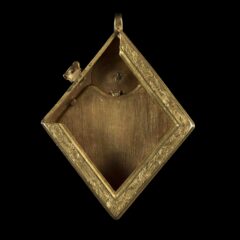Medieval ‘Love Token’ Ring Found by “Metal Detectorist”


A medieval gold ring which has gone on display after being found by a metal detectorist is likely to have been a 15th-century love token, an expert has said. The artefact, which is currently being shown at the Yorkshire Museum in York, is believed to have been owned by a “potentially prominent member of society.” It was found by detectorist Paul Ibbotson, lying beneath the surface of soil in a field at Fulford, near York, in December 2016, and was later legally declared as treasure.
The ring – a gold band engraved with flowers and set with ruby and emerald gemstones – was purchased by the York Museums Trust in 2019. Adam Parker, the assistant curator of archaeology for the trust, said the combination of the gemstones is “unusual”. He told the PA news agency: “It’s a rare item. Rings with rubies, sapphires or glass have been found before, but this dual bezel with both ruby and emerald is more unique.
Yorkshire Museum
The Fulford Ring is a beautiful gold ring set with a ruby and emerald and one of the finest examples of #medieval jewellery found in #York.
Gold finger rings set with two different jewels are rare archaeological discoveries and this is the first example ever discovered in York. Whilst we don’t know who the ring belonged to, its incredible artistry and rich materials make it one of the finest pieces of medieval jewellery from York.
The ring probably functioned as a love token or betrothal ring. Medieval lapidaries suggest that emeralds were associated with chastity and rubies with love and prevention of anger, which may have been important qualities in a medieval relationship. Other examples of rings with red and green settings display love mottos such as ‘With all my heart’ and ‘The good heart does not move’.
The sides of the hoop are decorated with a delicate and intricate floral engraving. Tiny flecks of black colour can still be seen within its design. These are traces of niello – a black-coloured enamel which originally filled the engraving. This would have contrasted dramatically with the bright gold and allowing the pattern to stand out.
The ring was bought by York Museums Trust in 2019 for £20,000 with funding from from the Headley Museums Archaeological Acquisition Fund, the Arts Council England/V&A Purchase Grant Fund, and public donations. The ring first went on public display in the Yorkshire Museum in September 2019.
Please note: The Yorkshire Museum is home to an extensive and varied collection of items and artefacts. Whilst we make every effort to display a broad spectrum of our collections it is not always possible for all our collections to be on display at once.

Curator of archaeology at York Museums Trust Lucy Creighton inspects the ring (Danny Lawson/PA)
Tap here for the York Museum and the Fulford Ring!
Also in the Museum Collection
A late 15th-century gold engraved pendant, set with a large semicylindrical blue sapphire, the Middleham Jewel was discovered by yet another metal detectorist, in 1985, near Middleham Castle, the northern home of Richard III.

Visiting York, I swung by the Yorkshire Museum to see the Middleham Jewel.
The museum suggests this very high status piece of C15th jewellery may have belonged to Richard III’s queen, Anne Neville.
It’s difficult to tell from this image (as it was when looking at the case) but this is actually the front and back of a small reliquary pendant
– there is an open space in the rear where pieces of silk were found, presumably the relics of a holy individual.
The exact owner, and source of the relics, remain a mystery, but it is an astonishing piece of medieval craftsmanship.
Each side of the lozenge-shaped pendant is engraved with a religious scene. A high status item, it may have been owned by a relation of Richard III, possibly his wife Anne Neville, his mother Cecily Neville, or his mother-in-law Anne Beauchamp (1426–92), widow of Warwick the Kingmaker. The blue colour of the sapphire (related to the Virgin Mary), the presence of several female-saints, and the depiction of the Nativity scene suggest that the jewel may have been intended to assist childbirth.
The sapphire set above the Crucifixion may have been intended to have other magical or medicinal qualities as well, being able to cure ulcers, poor eyesight, headaches and stammers. The two words which follow the main Latin text – Tetragrammaton (the Latinised Hebrew name of God) and Ananizapta – may have been used as a charm against epilepsy.
Tap here to read the original post on the museum’s website!













